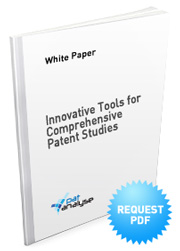Advanced Energy Storage Technologies

"Advanced Energy Storage Technologies: Patent Trends and Company Positioning"
This report contains detailed Patent Maps including ones using technology taxonomies. The report is provided with further insight into the conflicting picture between marketing and IP intelligence.
 Request White Paper Request White Paper
"Innovative Tools for Comprehensive Patent Studies"

 Download White Paper Download White Paper
"New Frontiers
in the Strategic Use of Patent Information"
 |
 Overview
There are big surprises. The car maker increasing its patent filings fastest from an already high level is one. Some apparently powerful players that seem to be dismantling R&D are another.
In order to deliver a series of multi-client Patent Mapping studies, PatAnalyse teamed with IDTechEx - a global analysis, strategic advice, and market intelligence company covering printed electronics, electric vehicles and allied technologies.
The first report "Advanced Energy Storage technologies: Patent Trends and Company Positioning" in this series provides an analysis of the rapidly developing technologies for the Lithium batteries, supercapacitors, and traction batteries used in electric vehicles.
The current boom in electric vehicles is related to the impressive improvements in Lithium-Ion battery technologies, which are starting to replace the older and lower energy density Lead Acid and Nickel Metal Hydride (NiMH) batteries. The new high energy Lithium-Ion cells, however, are more vulnerable to abuse and need the support of electronic battery management systems to provide protection and ensure a long life cycle. The battery itself, and on-board battery management system has become the important product differentiator, just like the engine in contemporary cars.
PatAnalyse has carefully developed the patent search strategy via several rounds of iteration. A combination of about 150 Assignees + 1,100 inventors + 2,600 patent codes (including IPC, ECLA, US patent codes) and about 1,250 keywords were used to carry out the patent search. As a rule of thumb, it takes at least five years from invention to the first product on the market. In order to focus on the 'hidden' R&D efforts which have not yet materialised as new products on the market, the initial study was restricted to patents with a priority date from 2005. However because of a significant increase in the rate of patenting in this area, this initial patent portfolio contains over half of all patents with a priority from 1990 in this area.
About 2,800 original Assignee names from the original bibliographic records were combined into 200 Top Assignees. The proprietary de-duplication algorithm aggregated about 12,000 simple patent families from about 40,000 national patents. Only 3% of the patent families have been left unassigned and it was further found that about 12% of the patent portfolio is assigned to small players with fewer than one invention per year. The remaining 85% of the patent portfolio is assigned to about 250 companies with about 66% of the patent portfolio assigned to the top 50 companies in terms of patenting.
Almost a hundred Patent Maps were provided in the report to facilitate the detailed analysis of various aspects of the patent landscape.
The report is organised in eight chapters:
- General overview of combined portfolio
- Generic Lithium Batteries technologies
- Further details of Anode chemistry
- Further details of Cathode chemistry
- Lithium Traction Batteries
- Traction batteries in general, their mounting and mechanical arrangement for cooling and heating
- On-board Electric Vehicles Battery Management System and external charging equipment
- Generic Supercapacitors technologies
Building on the marketing intelligence of our partner IDTechEx, the report pulls together a facts based analysis of patent filings over the years, customer relationships, and investments made by traction battery makers. It helps to answer such questions as:
- which chemistries, construction techniques etc. are prioritised by whom?
- which firms are spending heavily on new factories and gaining major sale successes but throttling back R&D so fewer patents are filed every year?
- what are the aspects prioritised by different regions, countries, companies and academia?
- which individuals are the most prolific inventors?
- which aspects receive more attention nowadays and which are increasingly ignored?
The report goes beyond the small and large scale Lithium-ion battery technology and looks at allied technologies such as on-board Electric Vehicle Battery Management Systems, EV battery charging stations, and supercapacitors (ultracapacitors). It shows the origin of work, profiles end-users of traction batteries in the automotive industry and highlights technology trends of patent filings.
We used a comprehensive set of technical categories for analysing relevant patents as listed below:
Generic Lithium batteries technologies
Cathode chemistry
Cathode manufacturing
Nanotechnology for cathodes
Nanotechnology for anodes
Anode chemistry
Anode manufacturing
Electrolyte - lithium salt
Electrolyte - solvents, polymers
Battery separator
Mechanical construction
Details of cathode chemistry
Lithium iron phosphates
Other lithium metal phosphates
Lithium cobalt oxide
Lithium cobalt nickel oxide
Lithium cobalt nickel manganese oxides
Other lithium cobalt complex oxides
Lithium manganese oxides
Lithium nickel oxides
Lithium nickel manganese oxides
Lithium-vanadium complex oxide
Lithium-titanium complex oxide
Other metal lithium oxides
Lithium-sulphur
Other lithium compounds
Carbon
Conductive polymers
Traction and large scale batteries in general
Li-based traction battery
non-Li traction batteries
Battery mounting in EV
Arrangement for cooling/heating
Supercapacitors for EV |
Details of anode chemistry
Lithium non-metal compounds
Germanium
Polymers
Carbon
Nano-form carbon
Graphite
Silicon
Silicon compounds
Silicon oxide
Other metal compounds
Tin compounds
Tin oxide
Vanadium oxide
Titanium oxide
Titanium compounds
Generic supercapacitors technologies
Asymmetric supercapacitors
Lithium ion capacitor
Electrode manufacturing
Nanotechnology for electrodes
Supercap electrolyte chemistry
Separator for supercaps
Supercap construction
On-board electric vehicle battery management system and external charging equipment
Battery temperature control
General monitoring of voltage and current
Battery recharging
Battery depth of discharge control
Battery or supercap balancing/redistribution
Battery related regenerative breaking
Battery safety system
Battery life prediction and modelling
Other commercial aspects of using battery in EV
External equipment related to battery recharging
|
|

